American Beech Tree: Grow & Care for Fagus Grandifolia
Written by Iris
Dec 07 2021
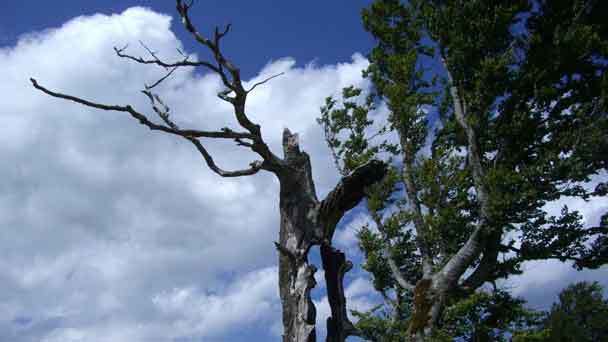
American Beech tree (Fagus grandifolia) is native to eastern North America, and it is found throughout North Carolina. American Beech tree is a sturdy, majestic large deciduous tree, typically growing to 60 to 80 feet or more, with a dense, upright oval to circular spreading crown and smooth bark that remains smooth with age. American Beech tree is a low-branched tree with mature trunks ranging from 2 to 3 feet in diameter.
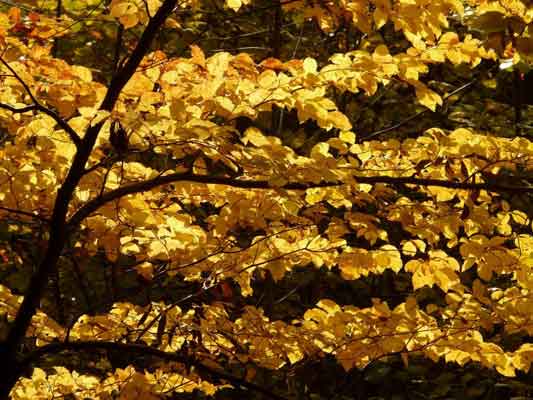
Scoop the seeds from the bowl of water and spread them out on a mesh screen. Position the seeds so they do not touch one another. Set the screen in a dark, dry room with a constant temperature of 65 to 75 degrees Fahrenheit. Leave the seeds for one to two days to dry.
Grasp a handful of sand. Dip the sand briefly underwater to moisten it. Hold the sand over a sink or bowl to allow the excess water to finish dripping away. Place the sand in a plastic zipper bag. Repeat this process to fill the bottom one-third of the bag with moist sand.
Place the dried beech seeds into the bag. Push the seeds down into the sand, fully covering their surfaces. Remove excess air from the bag, then seal it. Place the bag in a refrigerator with a constant temperature of 41 degrees Fahrenheit. Leave the bag in the refrigerator for 90 days. This is called "stratification" and it simulates a winter period in order to force the seeds from dormancy.
Pour 2 parts peat-free potting soil and 1 part sand into a bucket. Mix the materials together to combine them thoroughly. Add water slowly while stirring until the media is thoroughly moist but not soggy. Fill a 4-inch pot to 1 1/2 inches below its top with the media. Tamp the media down to settle it. Add media to the pot if needed to maintain the proper level. Prepare one pot in this manner for each beech seed you wish to plant.
Remove the bag of seeds from the refrigerator. Pull the seeds out of the sand and rinse them off in water. Place one seed in the center of each pot. Cover each seed with a 1/2-inch-deep layer of media. Tamp the media down over the seed.
Move the pots into bright filtered sunlight once the seeds germinate. Water when the top 1 to 2 inches of soil becomes dry. Turn each pot one-quarter turn once per week to encourage even plant growth.
Transplant the American beech tree seedlings into 1-gallon pots once they outgrow their current pots. Fill a 1-gallon pot one-half full of peat-free potting soil. Slide the seedling's root ball gently from its current pot. Place the seedling in the center of the new pot, adding or removing soil if necessary to position the top of its root ball 1 to 1 1/2 inches below the pot's top. Fill the pot with soil to the top of the plant's root ball, tamping the media down around the roots. Do not bury the seedling deeper than it was previously growing. Water the pot thoroughly. Repeat this process to transplant each seedling.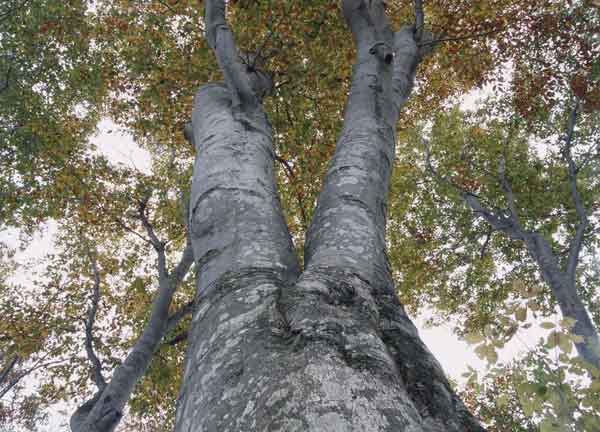
Spread a 2- to 3-inch layer of sphagnum peat moss across the planting area. Mix the moss into the top 6 to 8 inches of soil.
Dig a hole slightly shallower than the depth of the root ball and twice as wide.
Place the American beech tree root ball in the hole and remove the covering. Backfill the hole with the soil and moss mixture, adjusting the American beech tree so that the top of the root ball sits approximately 1 inch above the surrounding soil and the top roots are exposed.
Water the American beech tree thoroughly after planting and keep the soil moist, but not wet, watering weekly until the American beech tree is established. Resist the urge to fertilize your beech tree until it is well established.
Drive a stake into the ground next to your beech tree. Tie the tree to the stake loosely with cotton twine or gardener's tape. Newly planted beech trees are vulnerable to wind until established.
Apply a 3-inch layer of organic mulch, such as wood chips or straw around the base of the tree, but not touching the trunk.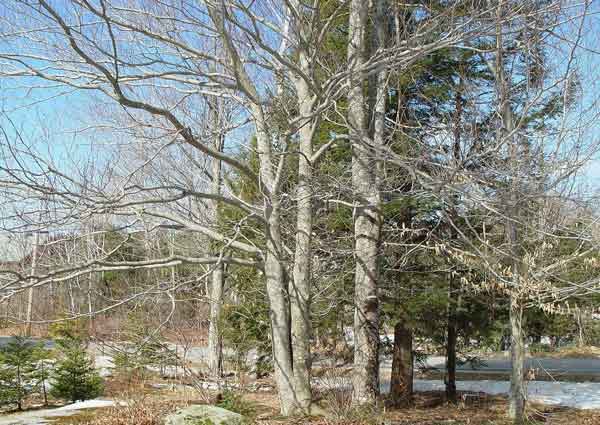
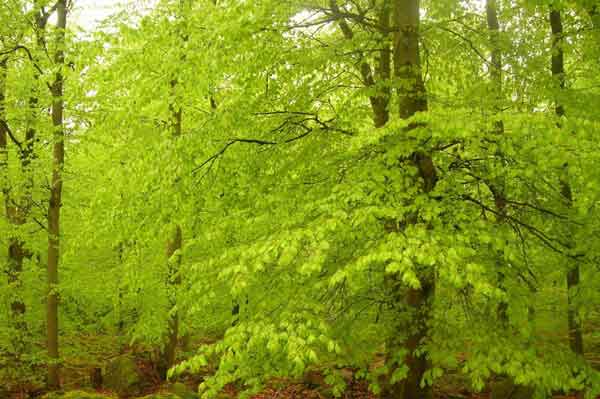
Usually none are serious provided soil is not compacted and is well-drained. Several fungi cause leaf spots but are generally not serious to warrant chemical control. Powdery mildew causes a white coating on the leaves. The disease is most common late in the season. Bleeding canker forms cankers from which a brownish liquid oozes. Crown symptoms include leaves of smaller size and lighter green color than normal. In severe cases the leaves wilt and the branches die. Avoid feeding with high nitrogen fertilizers as it seems to worsen the condition of infected trees. Beech bark disease occurs when the feeding site of woolly Beech scale is invaded by a fungus. The fungus kills the bark and in the process, the insects. There are no satisfactory controls for the fungus. Control the disease by controlling the scale with a horticultural oil. Cankers infect, girdle, and occasionally kill branches. Prune out the infected branches. During periods of high temperatures and low rainfall Beech may scorch. Make sure trees are adequately watered and mulched.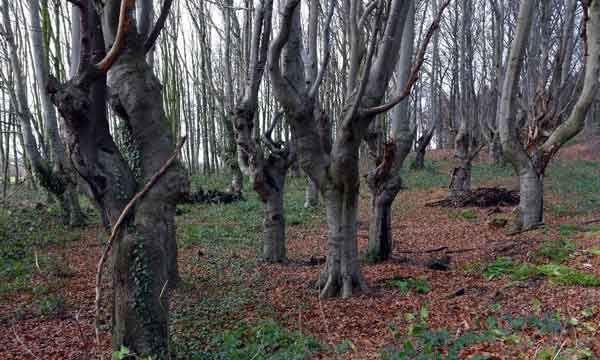
On the other hand, the European beech lumber has a light cream pink or brown color. Like the American Beech, the steam process gives the beech wood lumber a yellowish hue, but during production, the veneer comes out much darker. There is also a wide range of European beech trees known for their various orange hues.
Symptoms of Poisoning
Eating large quantities of unripe nuts can cause various forms of stomach upset, including vomiting and diarrhea. This most often occurs in dogs and occasionally grazing animals who feed on the nuts. The illness is usually self-correcting in a short time, and treatment is rarely needed.
Where to Grow American Beech TreeHow to Grow American Beech TreeAmerican Beech Tree Propagation with SeedsAmerican Beech Tree Propagation with Bare RootHow to Care for American Beech TreeAmerican Beech Tree Light RequirementsSoil for American Beech TreeAmerican Beech Tree WateringAmerican Beech Tree FertilizerAmerican Beech Tree PruningAmerican Beech Tree Pests & Diseases CareAmerican Beech Tree vs. European Beech TreeAmerican Beech Tree CareFAQsIs American Beech Tree Toxic?Is American Beech Tree invasive?Is American Beech Tree edible?
Where to Grow American Beech Tree
Your American beech tree is going to be around for generations. By the time the American beech tree matures, it can be over 70 feet tall with a spread that matches its height. The best planting site for American beech tree is one where the tree has room to grow without inhibition. Try to choose a location with 4 to 6 hours of direct, unfiltered sunlight every day. American beech trees can tolerate shade but does best in full sun. Find a spot with well-drained soil that stays somewhat moist. Ensure the soil is somewhat acidic and allows for the free flow of nutrients, water, and air. If the soil is compacted, aeration may be necessary before planting to ensure healthy growth. The American beech tree roots can spread great distances and will grow near the surface. Plant the American beech trees far enough away from hardscape features so they are not damaged by the sprawling root system. Remember, when grown individually, these American beech trees will develop a marvelous growth habit. American beech tree will have a wide, rounded crown and broad, spreading branches. Give it room to grow.
How to Grow American Beech Tree
American Beech Tree Propagation with Seeds
Lay a sheet underneath the branch of a American beech tree in the fall once the tree's seed pods become dry and begin to open. Shake the tree branch to dislodge the seeds and pods. Place the fallen American Beech tree seed pods and seeds in a bowl. Remove debris or clinging seed pods from the bowl, leaving the seeds behind. Fill the bowl one-half full of water. Discard any floating seeds as they will not germinate.Scoop the seeds from the bowl of water and spread them out on a mesh screen. Position the seeds so they do not touch one another. Set the screen in a dark, dry room with a constant temperature of 65 to 75 degrees Fahrenheit. Leave the seeds for one to two days to dry.
Grasp a handful of sand. Dip the sand briefly underwater to moisten it. Hold the sand over a sink or bowl to allow the excess water to finish dripping away. Place the sand in a plastic zipper bag. Repeat this process to fill the bottom one-third of the bag with moist sand.
Place the dried beech seeds into the bag. Push the seeds down into the sand, fully covering their surfaces. Remove excess air from the bag, then seal it. Place the bag in a refrigerator with a constant temperature of 41 degrees Fahrenheit. Leave the bag in the refrigerator for 90 days. This is called "stratification" and it simulates a winter period in order to force the seeds from dormancy.
Pour 2 parts peat-free potting soil and 1 part sand into a bucket. Mix the materials together to combine them thoroughly. Add water slowly while stirring until the media is thoroughly moist but not soggy. Fill a 4-inch pot to 1 1/2 inches below its top with the media. Tamp the media down to settle it. Add media to the pot if needed to maintain the proper level. Prepare one pot in this manner for each beech seed you wish to plant.
Remove the bag of seeds from the refrigerator. Pull the seeds out of the sand and rinse them off in water. Place one seed in the center of each pot. Cover each seed with a 1/2-inch-deep layer of media. Tamp the media down over the seed.
Move the pots into bright filtered sunlight once the seeds germinate. Water when the top 1 to 2 inches of soil becomes dry. Turn each pot one-quarter turn once per week to encourage even plant growth.
Transplant the American beech tree seedlings into 1-gallon pots once they outgrow their current pots. Fill a 1-gallon pot one-half full of peat-free potting soil. Slide the seedling's root ball gently from its current pot. Place the seedling in the center of the new pot, adding or removing soil if necessary to position the top of its root ball 1 to 1 1/2 inches below the pot's top. Fill the pot with soil to the top of the plant's root ball, tamping the media down around the roots. Do not bury the seedling deeper than it was previously growing. Water the pot thoroughly. Repeat this process to transplant each seedling.

American Beech Tree Propagation with Bare Root
Water the American beech tree root ball thoroughly before planting or allow bare root trees to soak in water while preparing the planting area.Spread a 2- to 3-inch layer of sphagnum peat moss across the planting area. Mix the moss into the top 6 to 8 inches of soil.
Dig a hole slightly shallower than the depth of the root ball and twice as wide.
Place the American beech tree root ball in the hole and remove the covering. Backfill the hole with the soil and moss mixture, adjusting the American beech tree so that the top of the root ball sits approximately 1 inch above the surrounding soil and the top roots are exposed.
Water the American beech tree thoroughly after planting and keep the soil moist, but not wet, watering weekly until the American beech tree is established. Resist the urge to fertilize your beech tree until it is well established.
Drive a stake into the ground next to your beech tree. Tie the tree to the stake loosely with cotton twine or gardener's tape. Newly planted beech trees are vulnerable to wind until established.
Apply a 3-inch layer of organic mulch, such as wood chips or straw around the base of the tree, but not touching the trunk.

How to Care for American Beech Tree
American Beech Tree Light Requirements
Both of these species grow best in full sun conditions. Although American beech trees prefer full sunlight, trees that grow in that condition will wind up being shorter but have a much broader crown. American beech tree can also grow in partial shade. American beech trees have adapted themselves to grow in these conditions because the dense canopy in beech forests does not allow a great deal of sunlight to reach the forest floor. Younger American beech trees grow at a rate of 1 to 2 feet per year. As such, American beech trees are forced to spend many years in the shadows of older trees. American beech trees were forced to adapt to the shady conditions to ensure a continuation of the species.Soil for American Beech Tree
Of all the conditions recommended for American beech trees, the most important is a deep, well-drained soil. A soil that drains well will discourage fungi. And furnishing a deep soil may help discourage the shallow rooting so problematic for this tree. Shallow rooting can wreck nearby hardscape features, causing sidewalks and driveways to heave.American Beech Tree Watering
For newly planted American beech trees, water weekly to ensure the soil stays somewhat moist. Keep this up for the first couple of years to ensure the roots establish themselves. Mature American beech trees are somewhat drought tolerant. However, during extended dry periods, you'll need to ensure that you're providing the tree with enough water to sustain itself. The shallow roots grow to wide breadths, so be sure to water the whole area of soil that contains them. You don't have to water American beech tree deeply, but doing so can encourage the shallow roots to grow deeper into the ground.
American Beech Tree Fertilizer
A balanced fertilizer is acceptable. In early spring, apply 1 pound of the fertilizer per 100 square feet. Spread it over the ground directly under the American beech tree's canopy and water it in.American Beech Tree Pruning
The American beech tree has a naturally attractive growth habit, with one central trunk that grows straight up and through the tree's crown. In general, American beech tree needs little pruning, but if two branches cross or rub against each other, one should be removed to prevent injury to the American beech tree's bark. Suckers, which are thin, straight branches that grow from roots or large branches, should also be removed, because they can weaken the tree. Pruning is best done during winter, when the American beech tree is dormant, or early in the spring before new leaves appear. Branches that are broken or damaged by wind can be removed at any time, to prevent entry of disease organisms.American Beech Tree Pests & Diseases Care
Aphid colonies on the lower American beech tree branches can be dislodged with a strong stream of water from the garden hose. Colonies are often disposed of by predatory insects. Borers such as flat-headed appletree borer or two-lined chestnut borer bore into trees weakened by stress. Prevent the insect infestations by keeping trees healthy with regular fertilization and irrigation in dry weather. Regular inspections of the trunk and branches are suggested for early detection of scales. Beech scale can be devastating to trees in the northeastern United States. Certain caterpillars can be controlled with sprays of Bacillus thuringiensis. Insect identification allows proper spray recommendations to be made.Usually none are serious provided soil is not compacted and is well-drained. Several fungi cause leaf spots but are generally not serious to warrant chemical control. Powdery mildew causes a white coating on the leaves. The disease is most common late in the season. Bleeding canker forms cankers from which a brownish liquid oozes. Crown symptoms include leaves of smaller size and lighter green color than normal. In severe cases the leaves wilt and the branches die. Avoid feeding with high nitrogen fertilizers as it seems to worsen the condition of infected trees. Beech bark disease occurs when the feeding site of woolly Beech scale is invaded by a fungus. The fungus kills the bark and in the process, the insects. There are no satisfactory controls for the fungus. Control the disease by controlling the scale with a horticultural oil. Cankers infect, girdle, and occasionally kill branches. Prune out the infected branches. During periods of high temperatures and low rainfall Beech may scorch. Make sure trees are adequately watered and mulched.

American Beech Tree vs. European Beech Tree
The color of the American beech tree lumber varies from cream to pink or brown. The American's plywood is darker than the European one, mainly because of the preparation process carried out with steam, which gives the wood a golden tinge. The color of the north american beech tree is generally more inclined towards reddish brown and has often a wider range of colors that give different variations between the wooden boards.On the other hand, the European beech lumber has a light cream pink or brown color. Like the American Beech, the steam process gives the beech wood lumber a yellowish hue, but during production, the veneer comes out much darker. There is also a wide range of European beech trees known for their various orange hues.
American Beech Tree CareFAQs
Is American Beech Tree Toxic?
Though ripe nuts of American beech tree are deliciously edible, the unripe nuts of this tree contain small amounts of a mild toxin known as fagin, confined mostly in the skin of the nuts. Large quantities of unripe nuts need to be consumed before ill effects occur, but this does occasionally happen with dogs and grazing animals. The American beech is less toxic than the European beech, but there are instances of poisoning, usually in the fall, when dogs or other animals eat the fallen nuts.Symptoms of Poisoning
Eating large quantities of unripe nuts can cause various forms of stomach upset, including vomiting and diarrhea. This most often occurs in dogs and occasionally grazing animals who feed on the nuts. The illness is usually self-correcting in a short time, and treatment is rarely needed.
Is American Beech Tree invasive?
American beech is a natural part of these forests, not an invasive species, and it does have key roles to play in its native habitats.Is American Beech Tree edible?
From the human point of view, the American Beech provides quite a few edibles. The inner bark is edible, young leaves are quite tasty while they are soft. The sweet seeds are very edible and can be crushed into a butter. Seeds have been crushed, boiled, and the nourishing liquid drank.Latest Updated
- Benefits of Bugleweed - 7 Science-backed Health Benefits
- Bugleweed Dangers & Side Effects - Is It Poisonous?
- How to Plant Evergreen Trees - What You Should Know
- When to Plant Evergreens - Grow Guide for Evergreen Trees
- 12 Wonderful Evergreen Shrubs for Your Garden
- 12 Popular Evergreen Plants with Pictures for Beginners
- When And How To Prune A Lilac Bush Like a Pro
- How to Grow & Care for Lilac Vine (Hardenbergia Violacea)
- Japanese Lilac Tree (Syringa Reticulata) Care & Propagation Guide
- Shumard Oak Pros and Cons - What to Know
Popular Articles
- Winter maintenance of Antirrhinum Majus
- How to Grow Terminalia Mantaly Tree
- How to Grow and Care for Crossostephium Chinense
- How to grow Antirrhinum Majus in spring
- Peristeria Elata (Dove Orchid) Profile: Info & Care Guide
- Underwatered Snake Plant (Sansevieria Trifasciata) - Signs And How To Fix
- How to Care for Brazilian Jasmine Plant (Mandevilla Sanderi)
- How to Grow & Care for Graptopetalum Purple Delight in Summer
- Rosa Chinensis (China Rose): Plant Growing & Care Tips
- How to Care for Baby Sun Rose (Aptenia Cordifolia)